Carol Simontacchi, CCN, MS, is a certified clinical nutritionist and the author of numerous books on nutrition. Ms. Simontacchi has appeared on many radio and TV shows, and her work has been featured in Newsday and other popular publications.
Contents
1. Introduction: The Body on Fire
2. A Little Fire Is a Good Thing
3. Fueling the Fire
4. The Pharmaceutical Approach
5. A Holistic Approach
6. Natural Anti-Inflammatories
Conclusion
Menu Plan and Recipes
Resources
References
About the Author
Index
"A timely rebuttal to the pill-first argument."
The Body on Fire
For people suffering from chronic pain, it wasn’t good news. And it came right before Christmas, too. First, Vioxx (rofecoxib) was removed from the market on September 30, 2004, because of increased risk of heart attack and stroke. Then on December 17, USA Today released a report stating that the over-the-counter pain reliever Aleve (naproxen) had been linked to a 50-percent increased risk of heart attack and stroke. This was followed in rapid succession by similar news about Celebrex (celecoxib).
Studies show that long-term users of both Vioxx and Celebrex have more than twice the risk of heart attacks than those taking a placebo drug. As of this writing, Bextra (valdecoxib) is on the ropes, too, and question marks hang over the entire class of COX-2 inhibitors, part of the family of NSAIDs (nonsteroidal anti-inflammatory drugs). What are people in pain supposed to do?
A GROWING PROBLEM
The anti-inflammatory drugs were introduced into the marketplace for a good reason: increased inflammation. Arthritis—both rheumatoid and osteoarthritis—has, of course, been around for a long time, as have the other disorders associated with chronic inflammation. (See the inset at right.) Chronic pain is difficult to bear, and people whose joints are painfully swollen are desperate for answers.
The market for effective pain relief is huge and growing. The population of the United States is rapidly aging, and we tend to become more vulnerable to inflammation as we age. Statistics on the number of people who suffer from arthritis vary, but according to the National Institute of Arthritis and Musculoskeletal and Skin Diseases (National Institutes of Health), more than 20 million people may suffer from arthritis. And joint pain is only one type of pain. Inflammation can arise and cause pain in virtually any tissue of the body, except for the brain, where there are few pain receptor sites. But many diseases and disorders of the brain—such as Alzheimer’s disease and autism—have now been positively correlated with inflammation. (See the inset on page 5.) When we tally up the number of health conditions that are causally linked to inflammation and the number of people who suffer from those conditions, we are talking about a vast segment of the population.
At the same time that the need for pain relief is growing, our country is experiencing a trend toward self-care, especially among the baby boomers. Sales of dietary supplements marketed to support joint health were $1.025 billion in 2001, and joint health is one of the fastest growing condition categories in the health foods industry. Over $566 million were spent on over-the-counter pharmaceutical joint health products in 2001. Moreover, people are also seeking the counsel of their physicians. Sales of prescription products for joint health totaled $8.114 billion in 2001—an increase of 39 percent over the previous year.
Most of us do not like to take the drugs. When Dr. Jones pulls out his pad and scribbles a prescription to take care of our latest medical problem, we sigh and ask, “Is it really necessary?” Yet, the physician would not prescribe it if he didn’t feel it was necessary.
The dilemma is that inflammation is a serious problem. The three top killers in Western society are heart disease, cancer, and diabetes. As stated in the inset on page 3, inflammation is a causative factor in cardiovascular disease, including stroke. Since metabolic syndrome—a collection of symptoms including abdominal and upper-body fat, increased serum cholesterol with an unhealthy imbalance between HDL and LDL cholesterol, and elevated triglycerides—is a precursor of diabetes, we can logically conclude that inflammation may very well be linked with the onset or progression of diabetes. And researchers believe that chronic inflammation may also be a factor in certain forms of cancer. In fact, the research project that recently illuminated the connection between the use of Vioxx and an increased risk of heart disease was seeking to determine just how, and how much, cancer may be causally linked with inflammation.
We hear more and more about rising health-care costs. How much does inflammation contribute to the health-care burden? In a few short years, Medicare will be unable to keep up with the growing costs. Insurance rates are rising faster than the Cost of Living Index, and there is no end in sight to skyrocketing prices. Millions of Americans can no longer even afford health insurance; they surely cannot afford to be ill. If we do not make radical changes in our personal diets and lifestyle, health-care costs may drive this affluent country into bankruptcy. We simply must do something.
THE PROMISE OF THIS BOOK
Fortunately, there is also a lot of good news. According to the United States government, we can completely avoid 80 percent of all health problems if we just make prudent lifestyle and dietary changes. In other words, we can take charge of our health simply by making the right decisions. This is certainly true of inflammation. We don’t have to suffer. We don’t have to choose between pain and heart disease.
We can lower our risks for developing chronic inflammation—and, at the same time, for developing other life-threatening diseases. We can make the choice to be well.
You are holding in your hands the first proactive step toward wellness—this book. The first step toward getting and staying well is solid information, based on good science and good clinical work. In our media-driven culture, we are bombarded with messages that conflict and confuse. But there is no need to be confused. Good health is really simple, but it has to start with honest, accurate information. I promise to provide science- and common sense-based information in this book, and I promise to make it both interesting and practical.
Step two involves taking a trip to your grocery store. The cornerstone of good health is a healthy diet. A healthy diet is not faddish or quirky. It does not deprive you of basic food groups or sensory pleasure. A healthy diet is simply prepared and frankly delicious! It does, however, require turning your back on most of the American food culture. If you have stopped cooking, you will need to start again, but you are ready to do that anyway, aren’t you? You are ready for vibrant health!
Step three toward wellness is restoring balance to your out-of-balance lifestyle. Stress and mental attitudes are directly linked to increased inflammation. I will recommend several changes that you will want to make in the way you live your life, and help you put these suggestions into practice.
Step four towards wellness is a dietary supplement program, using products that have been shown—in both scientific studies and traditional usage—to reduce inflammation and heal tissues. I will provide journal citations so that together, you and your doctor can make an informed decision about the products that will work best for you.
Are you tired of your pain? Are you ready to take charge of your health and get well? Then turn the page and get started . . .





